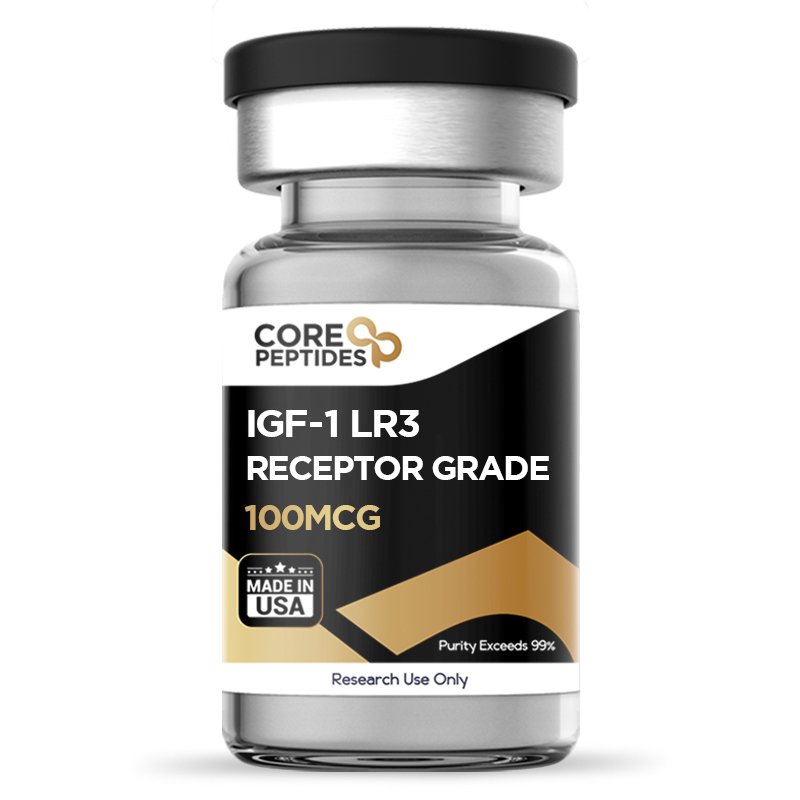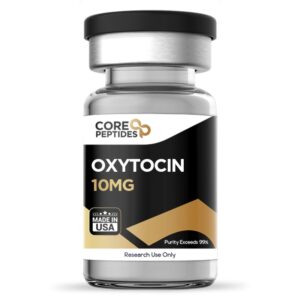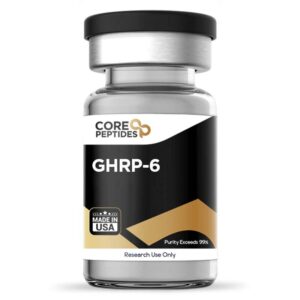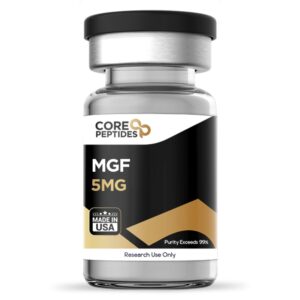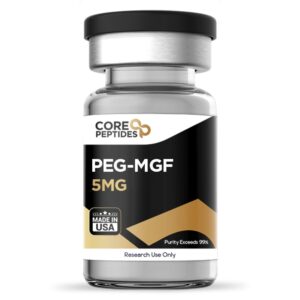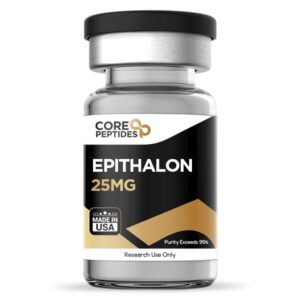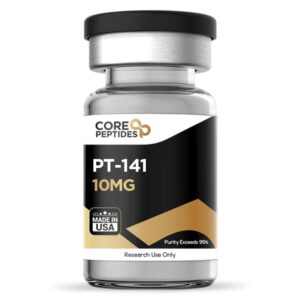Receptor Grade IGF-1 LR3 (100mcg)
$28.00
Size: 100mcg
Contents: Receptor Grade IGF-1 LR3 (100mcg)
Form: Lyophilized powder
Purity: >99%
SKU: P-IGF1LR3-100
FREE Shipping on $200+ orders
Discount per Quantity
| Quantity | Discount | Price |
|---|---|---|
| 5 - 8 | 5% | $26.60 |
| 9 + | 10% | $25.20 |
Receptor Grade IGF-1 LR3 Peptide
Insulin-like Growth factor-1, or IGF-1, is a naturally produced protein with 70 amino acids. Receptor Grade IGF-1 LR3 is a synthetic variant of the naturally occurring IGF-1, which contains an extended N-terminal structure of 13 amino acids and a replacement of the glutamic acid at residue 3 with arginine. Hence, it is named IGF-1 Long R3.(1)(2) Owing to the altered structure, Receptor Grade IGF-1 LR3 has been suggested to have increased affinity and increased anabolic potential while also binding less to IGF-1 binding proteins (IGF-1BPs). Structurally similar to insulin, this IGF-1 LR3 has the potential primarily to regulate cell tissue growth and development. This potential has been evaluated in cell growth studies, throughout which researchers first prompted the need for developing this high-potency variant. Moreover, the classification of Receptor Grade refers to the purity of the material, which is considered higher than Media Grade IGF-1 LR3.
Chemical Makeup(2,3)
Molecular Formula: C400H625N111O115S9
Molecular Weight: 9117.5 g/mol
Other Known Titles: Long-(arg3) insulin-like growth factor-I, Insulin-like growth factor long chain R3
Research and Clinical Studies
Receptor Grade IGF-1 LR3 and Anabolic Potential
Unfortunately, research on the anabolic potential of IGF-1 LR3 is lacking, as the peptide is aimed towards cell culture studies. Yet, of the few experiments in murine models, researchers have suggested the significant potential of the peptide.(1) In one study, experiments were carried out on normal and dexamethasone-induced catabolic murine models. It was noted that IGF-1 LR3 might potentially be 1.5 to 2 times as anabolic as IGF-I in inducing weight gain, increasing visceral organ weights, and possibly enhancing feed use efficiency under continuous delivery conditions. Moreover, IGF-1 LR3 appeared to have retained the potential for greater potency than IGF-I in several metrics, even in studies of only intermittent exposure. Additionally, in murine models exposed to dexamethasone, it was observed that the excretion of Nτ-methylhistidine—a marker indicative of muscle protein breakdown—appeared reduced to a greater extent by IGF-1 LR3, potentially threefold more than by IGF-I. This suggests that IGF-1 LR3 may host the potential, though not consistently equivalent across all parameters, to exhibit enhanced anabolic actions under certain laboratory conditions.
Therefore, Receptor Grade IGF-1 LR3 may be posited to exert even greater anabolic potential than IGF-1. To provide a comparison, several studies have researched the anabolic potential of IGF-1. For example, a study(4) was conducted in 2005 to study the potential of the peptide in models of IGF-1 deficiency. Following peptide exposure, the length and growth of the models were assessed and analyzed against control thresholds. Based on the study findings, it was observed that total length increased in all peptide-exposed models by a significant margin against the control standards. This study suggests that IGF-1, and possibly also more potent analogs like Receptor Grade IGF-1 LR3 peptide, may have some potential in mitigating growth deficiency.
Receptor Grade IGF-1 LR3 and Insulin Receptor Sensitivity
Research(5) has suggested that IGF proteins typically bind to IGF-1 receptors and may stimulate glucose uptake, potentially through a signaling mechanism involving PI3K and AMPK pathways. However, when studied, peptides like Receptor Grade IGF-1 LR3 appeared to induce glucose uptake not just through IGF-1 receptor interactions but also independently, possibly via other pathways or receptors. This suggests that the mechanism of glucose uptake might involve additional cellular processes beyond the traditional receptor binding. Assefa B Mahmoud et al. stated, "Multiple [...] studies reported the role of IGF-1 in enhancing insulin sensitivity and glucose metabolism. A low-serum level of IGF-1 has been associated with insulin resistance, and [...] recombinant IGF-1 has been [hypothesized] to improve insulin sensitivity and glucose metabolism.”
Receptor Grade IGF-1 LR3 and Cell Lifespan
Research(6) on murine models observed that common markers of physiological decline, such as muscle tears and neurological deficiencies, appeared to be mitigated for an extended period following routine exposure to the peptide. While more detailed studies and clinical trials are pending, the above preliminary study suggests that the peptide may indirectly help to increase lifespan of functional cells. As per William E. Sonntag et al.,
“Based on this review, we conclude that the perceived contradictory roles of growth hormone and insulin-like growth factor-1 in the genesis of the aging phenotype should not be interpreted as a controversy on whether growth hormone or insulin-like growth factor-1 increases or decreases life span but rather as an opportunity to explore the complex roles of these hormones during specific stages of the life span.”
Receptor Grade IGF-1 LR3 and Muscle Cells
A study(7) was conducted on female murine models to identify the IGF-1 LR3 peptide’s potential in decreasing the action of myostatin. Myostatin is considered to prevent cellular differentiation; mitigating the actions of this protein may increase lean muscle and reduce fat cell storage and fatty mass. The study's results suggested that the various IGF-1 analogs, including Receptor Grade IGF-1 LR3, appear to potentially reverse adverse myostatin and prevent apoptosis.
Receptor Grade IGF-1 LR3 and Shorter Action
An experimental mouse model was created for a study(8) where the IGF-1 LR3 peptide was compared to the endogenous IGF-1. Throughout the study, it was observed that when the peptide was exposed to the murine model, it appeared to quickly clear from the serum and evenly distribute into tissue. More specifically, the researchers posited that IGF-1 LR3 cleared faster as it appeared to bind to a lower degree to binding proteins than endogenous IGF-1. This reduced binding affinity means IGF-1 LR3 might circulate more freely than IGF-I. The analysis of tissue distribution patterns of IGF-1 LR3 also suggested a potentially unique localization compared to IGF-I. Elevated levels of the IGF-1 LR3 tracer were observed in tissues such as kidneys, ovaries, and adrenal glands in murine models. This distinct distribution suggests that the organs primarily involved in metabolic and reproductive functions may exhibit varying capacities for the uptake or retention of IGF-1 LR3 in contrast to IGF-I. It is hypothesized that these differences might stem from IGF-1 LR3's diminished propensity to form complexes with IGFBPs, which might influence its bioavailability and interaction with target tissues in experimental models. Nevertheless, further research suggested that a peptide with similar modifications (namely R3) to IGF-1 LR3 may exert increased anabolic potential compared to regular IGF-1 despite the shorter action.(9)
Receptor Grade IGF-1 LR3 peptide is available for research and laboratory purposes only. Please review and adhere to our Terms and Conditions before ordering.
References
- Tomas, F. M., Knowles, S. E., Owens, P. C., Chandler, C. S., Francis, G. L., Read, L. C., & Ballard, F. J. (1992). Insulin-like growth factor-I (IGF-I) and especially IGF-I variants are anabolic in dexamethasone-treated rats. The Biochemical journal, 282 ( Pt 1)(Pt 1), 91–97. https://www.ncbi.nlm.nih.gov/pmc/articles/PMC1130894/
- Human Insulin-like growth factor. Protein Data Bank in Europe, https://www.ebi.ac.uk/pdbe/entry/pdb/1gzr
- National Center for Biotechnology Information (2023). PubChem Substance Record for SID 381123731, M9L22Y19H9, Source: ChemIDplus. Retrieved January 24, 2023 from https://pubchem.ncbi.nlm.nih.gov/substance/381123731.
- Anderson, L. J., Tamayose, J. M., & Garcia, J. M. (2018). Use of growth hormone, IGF-I, and insulin for anabolic purpose: Pharmacological basis, methods of detection, and adverse effects. Molecular and cellular endocrinology, 464, 65–74. https://www.ncbi.nlm.nih.gov/pmc/articles/PMC5723243/
- Assefa, B., Mahmoud, A. M., Pfeiffer, A., Birkenfeld, A. L., Spranger, J., & Arafat, A. M. (2017). Insulin-Like Growth Factor (IGF) Binding Protein-2, Independently of IGF-1, Induces GLUT-4 Translocation and Glucose Uptake in 3T3-L1 Adipocytes. Oxidative medicine and cellular longevity, 2017 https://www.ncbi.nlm.nih.gov/pmc/articles/PMC5750484/
- William E. Sonntag, Anna Csiszar, Raphael de Cabo, Luigi Ferrucci, Zoltan Ungvari, Diverse Roles of Growth Hormone and Insulin-Like Growth Factor-1 in Mammalian Aging: Progress and Controversies, The Journals of Gerontology: Series A, Volume 67A, Issue 6, June 2012, Pages 587–598, https://doi.org/10.1093/gerona/gls115
- Naisi Li, Qiyuan Yang, Ryan G. Walker, Thomas B. Thompson, Min Du, Buel D. Rodgers, Myostatin Attenuation In Vivo Reduces Adiposity, but Activates Adipogenesis, Endocrinology, Volume 157, Issue 1, 1 January 2016, Pages 282–291. https://doi.org/10.1210/en.2015-1546
- Bastian SE, Walton PE, Wallace JC, Ballard FJ. Plasma clearance and tissue distribution of labelled insulin-like growth factor-I (IGF-I) and an analogue LR3IGF-I in pregnant rats. J Endocrinol. 1993 Aug;138(2):327-36. doi: 10.1677/joe.0.1380327. PMID: 7693845.
- Elis S, Wu Y, Courtland HW, Cannata D, Sun H, Beth-On M, Liu C, Jasper H, Domené H, Karabatas L, Guida C, Basta-Pljakic J, Cardoso L, Rosen CJ, Frystyk J, Yakar S. Unbound (bioavailable) IGF1 enhances somatic growth. Dis Model Mech. 2011 Sep;4(5):649-58. doi: 10.1242/dmm.006775. Epub 2011 May 31. PMID: 21628395; PMCID: PMC3180229.
